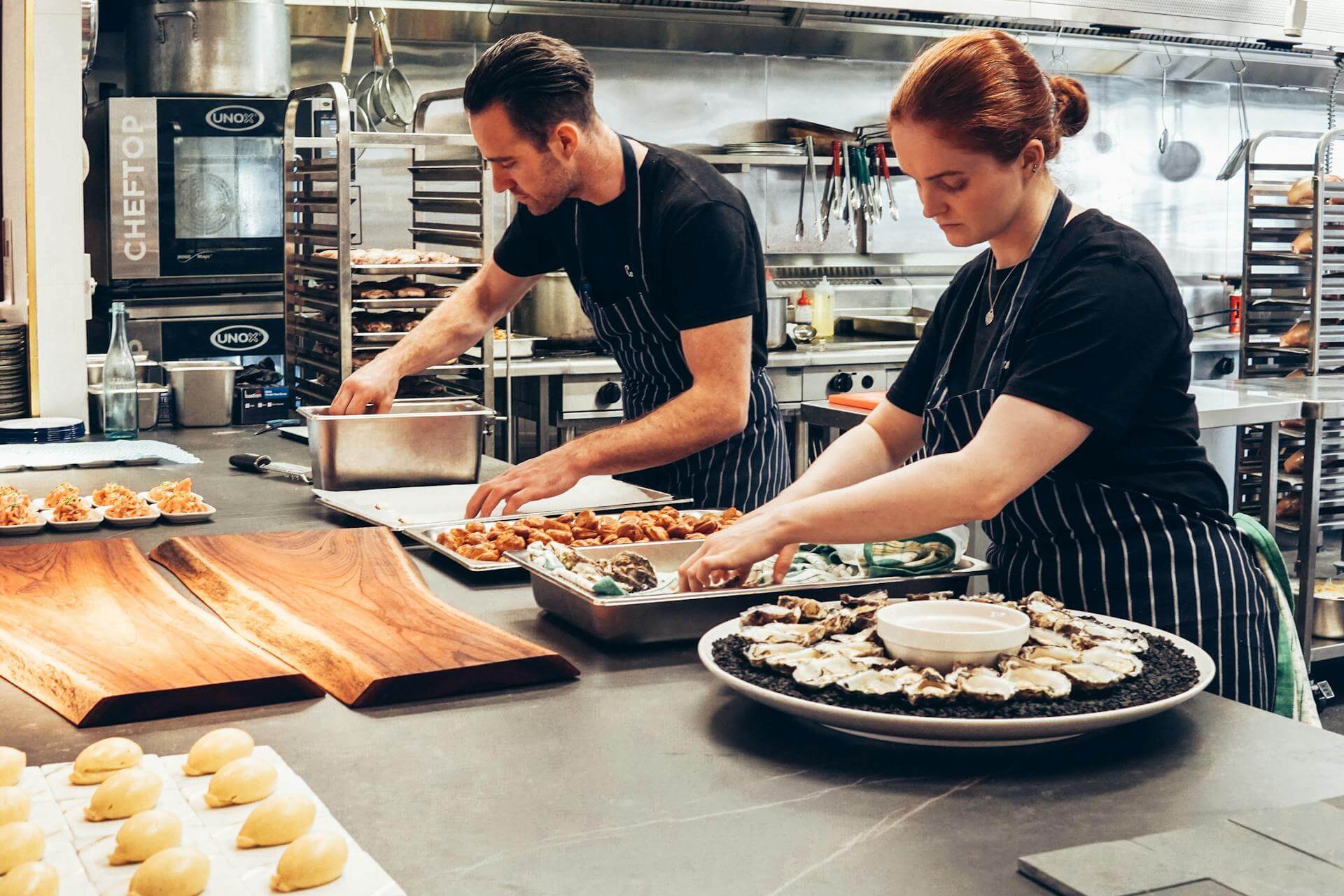The Future of Commercial Kitchens: Equipment Evolution
by Nathen Dubé

In the realm of commercial kitchens, equipment plays a crucial role in shaping culinary practices and ensuring operational efficiency.
The evolution of kitchen equipment has significantly impacted how food is prepared, cooked, and served, transforming the culinary landscape.
This article, part two to yesterday’s post, delves into the essential role of equipment in modern commercial kitchens. I’ll explore the evolution of kitchens and equipment, impact on culinary practices, and real-world examples from my KRG Hospitality projects.
Evolution of Kitchen Equipment
The journey of kitchen equipment from rudimentary tools to sophisticated technology reflects the advancements in culinary arts, and the increasing demands of the hospitality industry.
Early Tools and Techniques
In the early days, commercial kitchens relied on basic tools such as open flames, cast iron pots, and hand-forged knives. These tools required significant manual labor and skill, with chefs relying heavily on their expertise to produce consistent results.
The focus was primarily on the chef’s craftsmanship, as equipment offered limited assistance.
Industrial Revolution
The industrial revolution marked a significant turning point, introducing mechanization and standardization to kitchen equipment. Innovations such as gas stoves, steam ovens, and mechanical mixers began to appear, increasing efficiency and consistency.
These advancements allowed for larger-scale operations, and laid the foundation for modern commercial kitchens.
Technological Advancements
The late 20th and early 21st centuries saw rapid technological advancements in kitchen equipment.
The introduction of electric and induction cooktops, convection ovens, and computerized appliances revolutionized culinary practices. Equipment became more reliable, versatile, and capable of performing complex tasks with precision.
Modern Innovations
Today, the integration of smart technology and sustainability features has further transformed commercial kitchens.
From energy-efficient appliances to automated inventory systems and advanced cooking devices like sous vide machines, modern kitchen equipment is designed to enhance efficiency, consistency, and environmental responsibility.
Impact on Culinary Practices
The evolution of kitchen equipment has profoundly impacted culinary practices, influencing everything from food preparation to presentation.
Increased Efficiency and Consistency
Modern kitchen equipment is designed to streamline operations and ensure consistent results.
Appliances such as combi ovens, which combine steam and convection cooking, allow chefs to achieve precise control over cooking processes, resulting in perfectly cooked dishes every time. This consistency is crucial in maintaining high standards and meeting customer expectations in the hospitality industry.
Enhanced Food Safety
Advancements in kitchen equipment have also improved food safety standards. Equipment like blast chillers rapidly cool food, reducing the risk of bacterial growth and ensuring compliance with health regulations.
Additionally, touchless technology like automated faucets and soap dispensers minimize the risk of cross-contamination, creating a safer kitchen environment.
Sustainability and Cost Savings
Energy-efficient appliances and waste-reduction systems have become essential components of modern commercial kitchens.
Induction cooktops, for example, are not only faster and safer but also more energy-efficient than traditional gas or electric stoves.
Implementing waste management systems, such as composting and recycling, helps reduce environmental impact and can lead to significant cost savings.
Versatility and Creativity
Modern equipment has expanded the possibilities for culinary creativity. Tools like sous vide machines and smoking guns allow chefs to experiment with new techniques and flavors, pushing the boundaries of traditional cooking methods.
This versatility enables chefs to innovate and offer unique dining experiences that set their establishments apart.
Essential Kitchen Equipment in Modern Commercial Kitchens
Combi Ovens
Combi ovens are a staple in modern commercial kitchens due to their versatility and precision. By combining steam and convection cooking, they offer unparalleled control over temperature and humidity, ensuring consistent and high-quality results.
These ovens are ideal for baking, roasting, steaming, and more, making them indispensable in a busy kitchen environment.
Induction Cooktops
Induction cooktops provide rapid and precise heating, enhancing both safety and energy efficiency.
Unlike traditional gas or electric stoves, induction cooktops heat only the cookware, reducing the risk of burns and saving energy. Their precise temperature control allows for more accurate cooking, which is essential for achieving desired culinary outcomes.
Sous Vide Machines
Sous vide cooking involves vacuum-sealing food and cooking it at a precise, low temperature in a water bath. This method ensures even cooking and preserves the food’s flavor and texture.
These indispensable machines have become increasingly popular in commercial kitchens for their ability to deliver consistent, high-quality results with minimal effort.
Blast Chillers
Blast chillers are crucial for maintaining food safety standards in commercial kitchens. By rapidly cooling cooked food, blast chillers minimize the risk of bacterial growth and ensure compliance with health regulations.
This equipment is particularly important for operations that prepare food in advance or handle large volumes of perishable items.
Automated Inventory Systems
Automated inventory systems track stock levels in real-time, helping to reduce waste and ensure timely reordering. These systems provide valuable data on inventory usage, enabling more accurate forecasting and efficient supply chain management.
Implementing automated inventory systems can significantly improve operational efficiency and reduce costs.
Smart Appliances
Smart appliances like ovens, refrigerators, and dishwashers that can be controlled remotely are transforming commercial kitchen operations. These devices offer greater flexibility and efficiency by allowing chefs to monitor and adjust settings via smartphones or tablets.
Smart technology integration also facilitates better coordination and management of kitchen activities.
Hypothetical Concepts for Kitchen Equipment Integration
Concept 1: High-volume Catering Company
Imagine a high-volume catering company that needs to maintain consistency across large batches of food while also managing a complex supply chain. By integrating a comprehensive smart kitchen system, including smart ovens, refrigerators, and dishwashers, the company can monitor and control these appliances remotely.
Chefs would have the ability to adjust settings and monitor cooking processes from their smartphones, ensuring precision and efficiency. An automated inventory system would track stock levels in real-time, ensuring timely reordering and reducing waste.
This technological integration could significantly improve operational efficiency and product consistency.
Concept 2: Boutique Hotel Restaurant
Consider a boutique hotel restaurant aiming for a sleek, modern kitchen design that maximizes space and functionality.
A minimalist kitchen with handleless cabinets and integrated appliances could create a sleek, uncluttered look. Multi-functional workstations like prep stations that double as serving counters would maximize utility.
This design could provide the kitchen staff with a functional and efficient workspace that is easy to clean and maintain, enhancing both aesthetics and operational efficiency.
Concept 3: Eco-conscious Restaurant
Picture an eco-conscious restaurant committed to sustainability and reducing its environmental footprint. The kitchen could incorporate reclaimed wood for cabinetry and recycled glass countertops. Energy-efficient appliances, including induction cooktops and high-efficiency refrigeration units, could be installed to minimize energy consumption. A comprehensive waste management system featuring composting and recycling facilities would further reduce the restaurant’s carbon footprint.
These changes could maintain high operational efficiency while significantly reducing environmental impact.
Conclusion
The evolution of kitchen equipment has had a profound impact on the culinary practices and operational efficiency of modern commercial kitchens. From early tools to advanced smart technology, the continuous innovation in kitchen equipment has enabled chefs to enhance efficiency, ensure food safety, reduce costs, and explore new culinary possibilities.
Embracing these advancements makes it possible for the hospitality industry to create kitchens that are not only cutting-edge but also sustainable and efficient, ensuring long-term success in a competitive and ever-evolving landscape.
Image: Elle Hughes via Pexels


